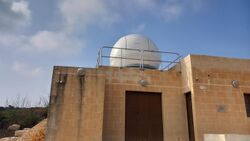Astronomy:Nadur Observatory
 The picture of the observatory | |
| Organization | Institute of Space Sciences & Astronomy, University of Malta |
|---|---|
| Location | Nadur, Gozo, Malta |
| Coordinates | [ ⚑ ] 36°03′34″N 14°16′25″E / 36.05944°N 14.27361°E |
| Established | May 19, 2023 |
The Nadur Observatory is the first astronomical observatory in the Maltese islands, located in Nadur, Gozo, Malta. Operated by the Institute of Space Sciences and Astronomy at the University of Malta, it recently captured its first light, marking a significant milestone for the scientific community in Malta and Gozo.[1]
Prior to construction
Funding
Funding for the construction of the Nadur Observatory was provided by the Directorate of EcoGozo within the Ministry for Gozo and the total cost for this project is estimated to be around 160,000.[2]
Site selection
The site selection for the observatory took into account comprehensive studies on light pollution. Given the significant light pollution challenges in Malta, the chosen site in Nadur was carefully determined through these studies, aiming to identify an optimal location for astronomical observations.[3] The observatory is built on an existing structure and houses a Ritchey-Chrétien mirror telescope with a half-meter-wide aperture, a configuration commonly utilized in professional research telescopes. Equipped with advanced instrumentation, the observatory's capabilities are enhanced for astronomical observations.[4]
Current use
The Nadur Observatory serves multiple purposes, including conducting research projects, providing specialized training for astronomy students in data acquisition and analysis, and engaging the general public through the dissemination of captivating space photographs and educational activities. Professor Joseph Caruana, the project coordinator, expressed his excitement regarding the observatory's successful first light and emphasized its potential for further scientific advancements.[5][1]
First light
The observatory utilized its telescope, to obtain images of certain celestial objects. Among the notable images obtained were the crescent moon and three distant galaxies: Whirlpool Galaxy (M51), Bode's Galaxy (M81), and Sunflower Galaxy (M63)[6] as well as a supernova in the Pinwheel Galaxy (M101).[7]
Reference
- ↑ 1.0 1.1 Agius, Monique (2019-10-23). "Nadur to get an astronomical observatory" (in en-US). https://newsbook.com.mt/en/nadur-to-get-an-astronomical-observatory/.
- ↑ "Astronomical observatory planned for Nadur" (in en). http://www.maltatoday.com.mt/news/national/98205/government_invests_160000_for_astronomical_observatory_in_gozo.
- ↑ Borg, Mario (2023-05-16). "Malta's First National Astronomical Observatory Photographs The Universe - Straight From Nadur" (in en-GB). https://lovinmalta.com/news/maltas-first-national-astronomical-observatory-photographs-the-universe-straight-from-nadur/.
- ↑ "Maltese Astronomers capture first space images from Nadur". https://tvmnews.mt/en/news/watch-maltese-astronomers-capture-first-space-images-from-nadur/.
- ↑ "Astronomical observatory to be set up in Nadur" (in en-gb). 2019-10-23. https://timesofmalta.com/articles/view/astronomical-observatory-to-be-set-up-in-nadur.744207.
- ↑ "Malta's first National Astronomical Observatory sees first light". https://www.um.edu.mt/newspoint/news/2023/05/malta-first-national-astronomical-observatory-sees-first-light.
- ↑ "Exploding star recorded by Malta's astronomical observatory in Nadur" (in en). 2023-05-21. https://gozo.news/103801/exploding-star-recorded-by-maltas-astronomical-observatory-in-nadur/.
 |

